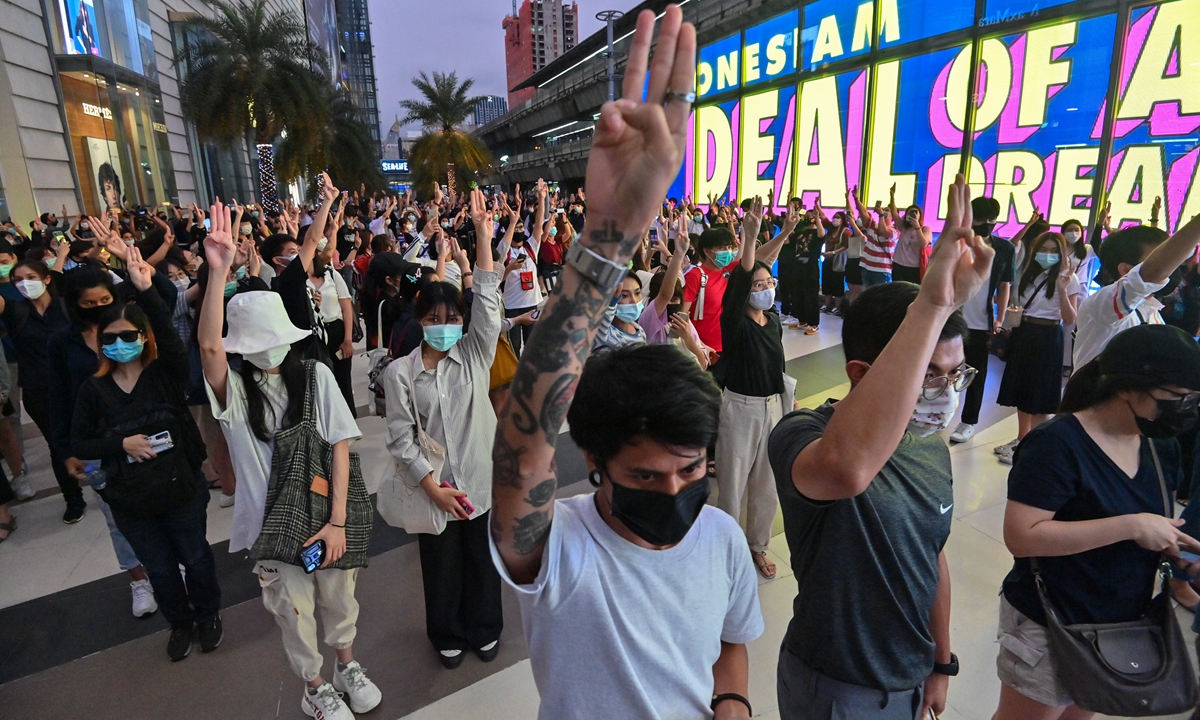Behind-scenes funding of Thailand protests show invisible Western hands
By Yu Qun Source: Global Times Published: 2020/10/21 18:56:14

Protesters give the three-finger salute during an rally outside Siam Paragon shopping center in Bangkok on Tuesday. Photo: AFP
Thailand's politics are heating up - with escalating street protests driven by anti-government forces. In response, the Thai government has announced an emergency decree in Bangkok on October 15. However, protesters have planned more rallies. The situation has drawn global attention.
Protesters claim their anti-government moves are rational for an array of reasons. For example, their country's economic recession has exacerbated rising unemployment rates. The new constitution, which was promulgated in 2017, was believed to only serve for strengthening and prolonging the ruling of military junta. Yet it is not hard to find that the current riots in Bangkok resemble the 2019 Hong Kong turmoil.
First, the rallies are mainly made up by young people. This is different from previous Thai street protests between the "Yellow Shirts," those opposed to former Thai prime minister Thaksin Shinawatra and his successors, and "Red Shirts," supporters of Thaksin.
Second, the rallies are well organized. There is no doubt that they are funded by some individuals or organizations behind the scenes. Take the gathering on Friday. The protesters were well furnished with protective gear such as helmets, goggles and umbrellas. It is obviously difficult for common students to raise funds for such gear.
Third, the patterns of the rallies in Bangkok are similar to those in Hong Kong. Anti-government protesters attempted to occupy public places, such as local landmarks, downtown shopping malls, and subway stations. This was all done in a bid to trigger broad attention from the international community. They used umbrellas as a sign of the protests. Protesters played cat and mouse with police by randomly deciding the location and time for protests.
Fourth, in a striking similarity to protests in Hong Kong, unidentified Westerners at rallies in Thailand openly instructed students to set up stages and barricades. There was also a very professional camera team hiding in the crowd to capture "touching" scenes. These images included protesters kneeing before officers and armed police swinging batons in front of unarmed protesters. Such photos went viral on social media platforms. They incited ordinary people's hatred against the "brutal" government and thereby turned them into protesters. This was a clear recruitment campaign.
It is worth noting that some Hong Kong rioters, including their leader Joshua Wong, have publicly supported Thai anti-government protests. This reminds people of the group photo featuring Wong and Thanathorn Juangroongruangkit, who served as the leader of the Future Forward Party that was dissolved by Thailand's Constitutional Court in February.
The Thai government and mainstream media believe that anti-government forces in the country have colluded with the US and other Western countries to use young people with the ultimate goal to overthrow the current political system in Thailand. Those forces aim to bring in pro-West political proxies to rule the country with Western-styled democracy. It is essentially a "color revolution."
This is in line with the US' general practice. The US manipulated color revolutions in the former Soviet Union, the Middle East, and other countries and regions for its political intentions, leaving many countries in a mess, threatening regional and world peace and stability.
It is unclear whether the Thai young generation, who are currently being used as cannon fodder by the US and its proxies, actually understand that a color revolution is not as beautiful nor peaceful as portrayed.
The author is deputy director of the Military Diplomacy Research Center of the College of International Relations, National University of Defense Technology. opinion@globaltimes.com.cn
RELATED ARTICLES:
Posted in: ASIAN REVIEW